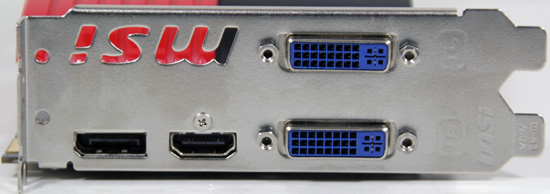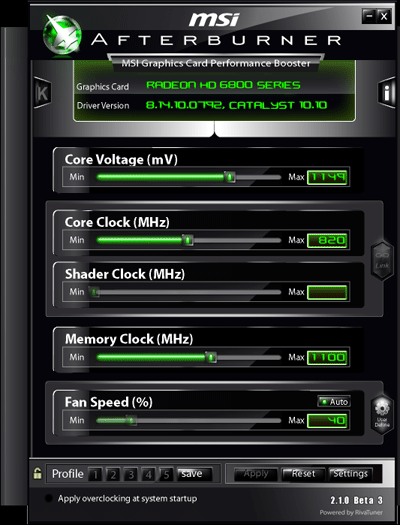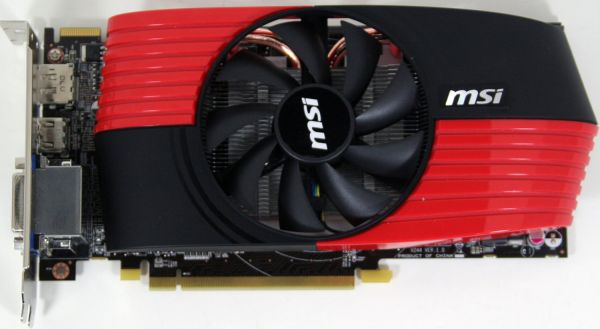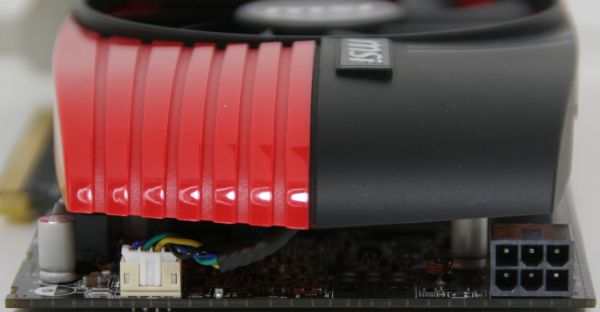AMD Radeon HD 6850 Overclocking Roundup: Asus, XFX, & MSI
by Ryan Smith on November 8, 2010 12:40 AM ESTMeet The MSI R6850 OC
The final card in today’s roundup is MSI’s R6850 OC. The R6850 OC is one of the first 6850s being released with a significant overclock, with MSI releasing it at 820MHz core and 1100MHz (4400MHz effective) memory, a 45MHz (5.8%) core and 100MHz (10%) memory overclock respectively. Besides the overclock, the card is identical to MSI’s existing R6850, using the same PCB and cooler as its stock-clocked counterpart.
Starting with the PCB, MSI is also using a non-reference PCB, this time using a shorter 8.5” PCB. In fact it's the same PCB as on the XFX card, leading us to believe that this is an alternative 1x DisplayPort PCB from AMD. In any case, because it's the same PCB as the XFX it means it's sharing the same design flaws: MSI has kept the PCIe power sockets on the rear of the card, so the practical length of the card is longer. Furthermore in the case of the MSI card, the card’s plastic shroud hangs over the end of the card, making the card 9” long in practice. As a result the end-user benefits of the shorter PCB are more or less wasted.
Attached to the PCB is MSI’s cooler, which bears a striking resemblance to Asus’s DirectCU cooler. Here MSI is using a pair of copper heatpipes to transfer heat from the baseplate to an aluminum heatsink that runs most of the length of the card. In the center is an 80mm fan providing airflow for cooling, and on top of that a shroud to direct airflow out of the front and the back of the card. Compared to the Asus DirectCU cooler, the biggest differences are that MSI is using a larger fan and copper heatpipes in place of aluminum heatpipes.
As for the port configuration, MSI is using the same configuration as both XFX and Asus: two DVI ports, one HDMI port, and one full-size DisplayPort, meaning the card can drive up to 5 monitors with a DP hub.

For the R6850, MSI’s ace in the hole is the software rather than the hardware. The R6850 comes with MSI’s fantastic Afterburner software, which comes with allows overclocking and monitoring, and on the R6850 it even allows voltage modification. While MSI makes this software available for use on non-MSI cards, we always make it a point to tip our hat in their direction as Afterburner continues to be the gold standard in overclocking software.

Rounding out the package is the usual collection of odds & ends: a quick-start manual, driver/utility CD, molex-to-PCIe power adaptor, a long CrossFire bridge, and a DVI-to-VGA dongle. Unfortunately we don’t have pricing information for the R6850 OC at this time, but we’ve already seeing the stock-clocked version at around $190, so we’d expect the R6850 OC to go for around $200, a $20 markup over the AMD MSRP for a reference card and roughly in-line with other factory overclocked cards. Meanwhile on the support side of matters, MSI is providing a 3 year warranty with the card.


















93 Comments
View All Comments
spigzone - Monday, November 8, 2010 - link
Ryan - "It was made abundantly clear to us in the comments in our follow-up piece and in emails to us that you guys disapproved of our inclusion of non-reference cards in articles."Your statement utterly disingenuous = DISHONEST.
It was crystal clear the howl that went up was specifically for using massively overclocked GTX460 cards in the FIRST REVIEW of the new AMD GPU series AND that it violated your own editorial policy on such 'first' reviews AND at that you didn't even include a Overdrive o/c'ed 6850/5870 for comparison.
It was ALSO crystal clear the readers DO want non-reference and o/ced cards in FOLLOW UP articles.
LIKE THIS ONE.
THIS IS WHERE ALL THOSE O/Ced AND NON-REFERENCE CARD STATS BELONG.
This is really disappointing.
And VERY dishonest.
7Enigma - Monday, November 8, 2010 - link
While a little harsh, this is pretty much dead on (once you weeded through all the fan-boy posts that had no sane basis other than a love/hate for their particular brand).And as mentioned the fix for this is so simple it shouldn't take more than an hour to correct. Put the 460 FTW in the charts, mention the pricing is more than the 6850 variants and let the buyers decide.
mapesdhs - Monday, November 8, 2010 - link
Hear hear!
The closing comment in the article is really dumb. Nobody in their right mind
would buy a stock 460 1GB for reasons I posted about before (they're either
more expensive than oc'd 460s, or not available at all - some sellers only
sell oc'd versions; one seller's _cheapest_ 460 1GB has an 800 core!).
So in the equivalent but opposite manner to the earlier article, readers are
left with a misleading and inaccurate conclusion. That's a real shame. The
earlier article was good because it showed how a real card that I could buy
performed. This article gives no useful comparison info at all as that same
card is left out, all because of a bunch of moaners. While I didn't agree with
those who opposed the inclusion of the FTW in the earlier article, the strong
sense from all of them was that they thought such cards *should* be included
in this kind of article. Oh dear...
This is like watching a pilot sheer a plane left/right too hard in turbulence -
no sensible middle course adopted, so the tail fin falls off. What some
perceived as an earlier mistake has merely been made worse.
Ian.
tomoyo - Monday, November 8, 2010 - link
I don't think there's any dishonesty here at all. While I just mentioned that Ryan did make mistakes, I think they were 100% honest mistakes. His goal is to satisfy the readers. I think the effort is there, but in this case, the way it was handled was incorrect. It's pretty ugly to accuse someone of dishonesty without any reason to.Ramon Zarat - Monday, November 8, 2010 - link
I didn’t read the whole 5 pages of comments, I didn’t need to.The very first comment and the subsequent “attempts” to address it was more than enough for me and unfortunately, even reinforced the impression of partiality toward Nvidia many noticed in the first article.
This second article was the perfect opportunity to set the record straight and prove once and for all the 6850 is indeed a better buy over the 460, even a cherry picked and overclocked to death one. Pitting them one against the other was the thing to do, but no, Anand didn’t. Asking why he didn’t is kind of answering the question.
The reality is those 6850 can all hit 1Ghz on air with the help of a slight voltage adjustment. Most reach 950Mhz at stock voltage. Some even report near 1.1Ghz stable, still with air cooling, but at 1.3V. The 460 can do 850Mhz on air under the best of circumstances, period.
What we all want to see is an overclocked to death 460 against an overclocked to death 6850. Ask both Nvidia and AMD to send you the best of their respective sample and let see what a 460 at 850Mhz can do against a 6850 at over 1Ghz… If we are to accept bogus cherry picked sample, and we all know the limited 850Mhz edition are just that: super top cream golden cherry not representative of the vast majority of 460 GPU, lets assume ourselves entirely.
Give us the power and thermal at those speeds. Also do a SLI VS CF at those settings.
Again, we all know the answer: The 6850 destroys the 460 on power, speed, scalability and price ratio when apple to apple protocol is applied.. For some reason, this web site doesn’t want you, the reader, to know about it.
Ramon.
El_Capitan - Monday, November 8, 2010 - link
Really, read the 5 pages of comments. Maybe you can also stop speaking out of your ass.http://forums.overclockersclub.com/index.php?showt...
http://img101.imageshack.us/i/furmarksingle4601005...
Listen, it's fine if the HD 6850 overclocks like a monster and there's results to prove it, but don't belittle the GTX 460 1GB with bogus claims. Why don't you provide us with some proof? Obviously AnandTech can't provide it, but you know how to Google, right?
7Enigma - Monday, November 8, 2010 - link
I spent a bit of time over my lunch break to compare the Asus OC 6850 card in this review and the FTW 460 in the previous review. I put together a table in Excel but will have to summarize since this comment system is so archaic.I chose the Asus for 2 reasons: it was the top pic in this roundup due to power draw and noise and could OC to the same levels at 1.172, and it has such a low OC that at "stock" OC it is basically a reference 6850.
Here is my summary:
-At STOCK OC the Asus is 13-24% slower than the 460 FTW (10%, 13%, 24%, 13%, and 17% for Crysis, Battleforge, Civ 5, BC2, and ME2 respectively)
-At 940MHz core only CIV 5 has a significant win for the 460 FTW (16%), the other games are a wash (-2 to 2%)
-Idle power consumption is equal (I had to use the reference 6850 from the previous article since it is not in this OC article but they should be within a watt or two)
-Load power consumption in Crysis is 13.5% lower with the Asus as compared to the 460FTW (269w vs. 311w)
-Load power consumption in Furmark is 18.4% lower with the Asus as compared to the 460FTW (292w vs. 358w)
-Idle noise levels are equal (again had to base this off of the previous article at reference clocks so could be slightly higher at idle but not likely)
-Load noise levels are 3.5dB higher with the Asus as compared to the 460FTW (that IS significant as 3 dB is a doubling in sound pressure)
So here's my recommendations:
If you care only about performance the 940MHz OC'd Asus is tough to argue against. It's cheaper and behaves almost exactly like a 460FTW in the games tested except for CIV 5 where it is 16% slower at 1920X1200 resolution (both still very playable at 35.5fps and 42.2fps)
If you care about power consumption the 940MHz OC'd Asus uses significantly lower power (13.5-18.5% less, 40-60w less)
If you care about noise level the 940MHz OC'd Asus is significantly louder than the 460 FTW (3.5dB higher).
If you do not want to OC these cards and use them strictly at their "stock" OC speeds the 460FTW is in a different class (both price and performance). The upgrade is worth it.
So basically the only situation I would recommend the 460FTW over one of these 6850 OC cards (knowing that they *should* OC to 940MHz core, 1150MHz ram) is if the user does not plan to OC the card. And for that reason I definitely think the 460 FTW should have been compared in this review of aftermarket OC cards as it significantly changes the conclusion of the previous article.
Sorry for the long rant.....
spigzone - Monday, November 8, 2010 - link
Long post maybe, but that was the opposite of a rant.Thanks for taking the time to lay out the hard numbers on this.
El_Capitan - Monday, November 8, 2010 - link
Yup, same sentiments.SunLord - Monday, November 8, 2010 - link
I've yet to find a single 6850 that has two mini display port since launch and I highly doubt that they exist in the US if at all outside of the AMD branded reference card.